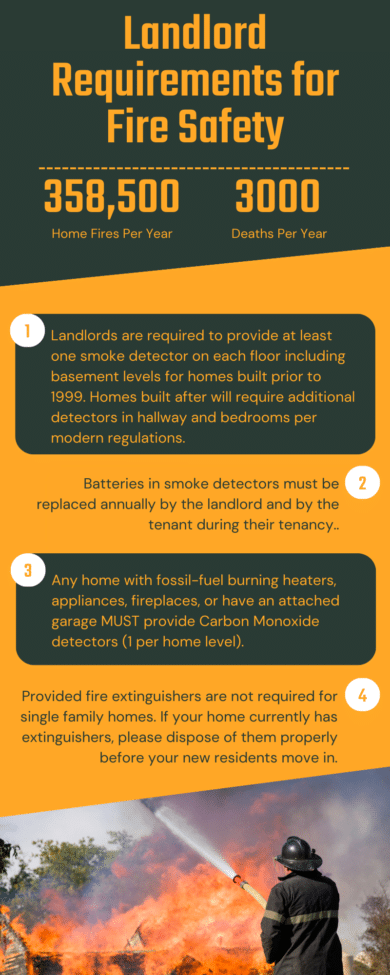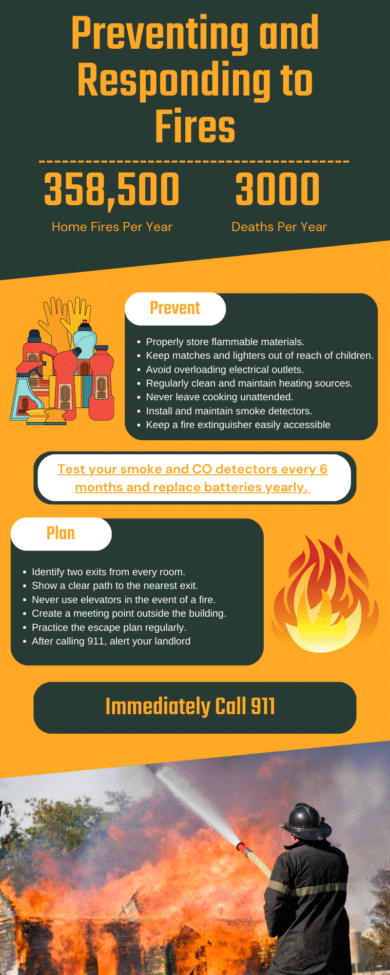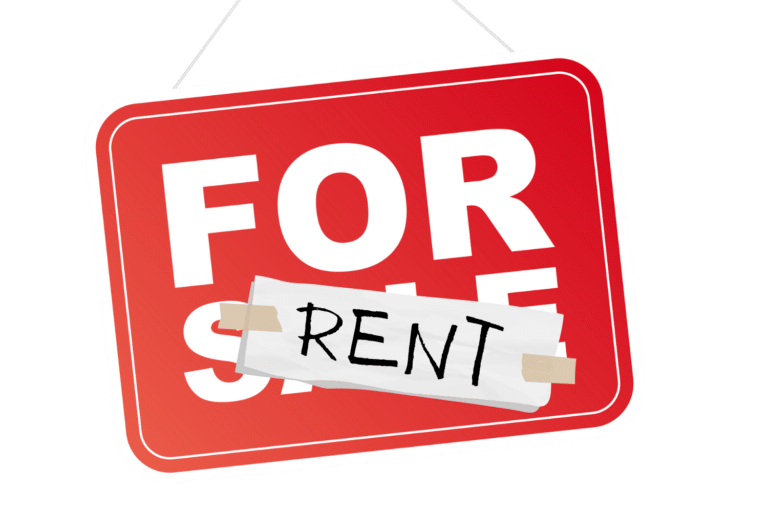- House fires can reach temps of 1100 degrees in 3.5 minutes.
- On average, 7 people die a day from fires.
- More than 3000 people a die every year in America due to fires.
- Cooking, heating equipment, and electrical failures are the top three causes for house fires.
Fire Safety Responsibilities for Landlords
As a landlord, ensuring fire safety in your rental properties is a critical aspect of protecting your investment and your tenants. Failure to meet fire safety regulations can result in severe penalties, financial losses, and even legal liability. This comprehensive guide will cover the various responsibilities that landlords have in maintaining fire safety, as well as the steps that can be taken to prevent apartment fires.
1. Know Your Local and State Fire and Building Codes
Fire and building codes can differ from state to state and even from city to city. It is essential for landlords to become familiar with the codes specific to their area. Some common fire safety regulations that landlords should be aware of include:
- The number of smoke detectors required in each unit
- Carbon monoxide detector requirements
- Fire extinguisher requirements, placement, and maintenance
- Emergency exit and escape route requirements
- Sprinkler system requirements
Keep in mind that these are just a few examples, and it is crucial to consult your local and state regulations for a complete understanding of your responsibilities.
2. Conduct Regular Fire Safety Inspections
Regular fire safety inspections are a critical part of maintaining a safe rental property. These inspections should be conducted at least once a year:
- Test smoke and carbon monoxide detectors and replace batteries yearly
- For multi-family properties, a yearly fire extinguisher inspection is required by the fire department
- Check electrical outlets and appliances for signs of wear or damage
- Examine heating systems and chimneys for potential hazards
- Ensure that emergency exits and escape routes are clear and unobstructed for multifamily units
Document the results of your inspections and keep a record for your insurance company and potential legal matters.
3. Install Smoke Detectors and Carbon Monoxide Detectors
Smoke detectors are a crucial component of fire safety in rental properties. Standards for smoke detectors change regularly and are often determined by the age of the home. Homes built before 1999 typically only require one smoke detector on each level of the home including the basement. Homes built after 1999 require one on each floor, in each bedroom, and oftentimes in hallways. Carbon monoxide detectors are required for any home with fossil-fuel burning appliances, fireplaces, and even attached garages.
Repair Costs.
It gets more expensive every year to do maintenance and repairs. Why??

4. Fire Extinguishers and Regular Maintenance
Single family homes are not required to be provided fire extinguishers. In fact, its best to encourage your residents to provide their own and make it their responsibility to maintain. Fire extinguishers do expire and do require yearly inspections.
Multifamily properties should provide fire extinguishers in common areas that are easily accessible. This includes hallways, breezeways, pools, and clubhouses. Make special note to have your extinguishers inspected yearly.
5. Ensure Proper Ventilation and Heating Safety
Poor ventilation and heating safety can lead to an increased risk of fires and carbon monoxide poisoning. Ensure that all appliances, including heating systems and water heaters, are properly vented and regularly inspected for potential hazards. Educate tenants about the dangers of using portable heaters and the importance of keeping them away from flammable materials.
Fireplaces are often forgotten about and not routinely inspected. Some communities require homeowners to hire a professional to inspect and clean out chimneys each year. Wood-burning fireplaces can collect soot blocking out ventilation and causing smoke to roll back into a home or even catch fire.
6. Establish Rules for Smoking and Open Flames
Implement a clear smoking policy in your lease agreement, which may include designated smoking areas or a complete ban on smoking in or around the property. Additionally, set rules for the use of candles, grills, and other open flames to minimize the risk of accidental fires.

Fire Safety Tips for Tenants
As a tenant, it is essential to take an active role in maintaining fire safety in your rental home. This section will provide essential fire safety tips and advice on how to keep your living space safe from potential hazards.
1. Test Smoke and Carbon Monoxide Detectors Regularly
Regularly test your smoke and carbon monoxide detectors to ensure that they are functioning correctly – at least every 6 months. During your tenancy, it is your responsibility to replace batteries as needed and notify your landlord if you encounter any issues with the devices.
2. Use Appliances Safely
Always follow the manufacturer’s instructions for safe use of appliances, such as stoves, ovens, and space heaters. Keep flammable materials away from heat sources and never leave cooking unattended. Unplug small appliances when not in use to minimize the risk of electrical fires.
3. Practice Electrical Safety
The NFPA reported that between 2015-2019 46,700 home fires involved electrical malfunction or failure. Avoid overloading outlets and extension cords, and inspect cords and plugs for signs of wear or damage. If you notice flickering lights or other electrical issues, notify your landlord immediately.
4. Keep Exits and Escape Routes Clear
Its always best to create a fire escape plan with your household and practice if regularly. Ensure that all exits, including windows and doors, are unobstructed and can be easily opened in case of an emergency. Keep hallways and stairwells clear of clutter and debris to allow for a safe and efficient evacuation if necessary.
5. Maintain a Safe Cooking Environment
Keep your cooking area clean and free of grease buildup, and never leave cooking unattended. If a grease fire occurs, never use water to extinguish it—instead, smother the fire with a pot lid or use a fire extinguisher specifically designed for grease fires. Using water on a grease fire will only ignite the flames further.
6. Use Candles and Open Flames Responsibly
Never leave candles or other open flames unattended, and keep them away from flammable materials such as curtains and bedding.
7. Follow Your Landlord’s Smoking and Grilling Policies
Adhere to your landlord’s smoking policy, and only use grills in designated areas following the proper safety guidelines. Keep grills at least 10 feet away from the building and any overhanging structures.
Unless noted, the use of grills on apartment balconies is prohibited.
8. Learn How to Use a Fire Extinguisher
Familiarize yourself with the proper use of a fire extinguisher and know where they are located. In case of a fire, only attempt to use a fire extinguisher if the fire is small and contained, and you have a clear escape route. If a fire extinguisher is not provided, you can purchase one at any major hardware store. Keep your extinguisher in an easily accessible location away from potential hazards.
9. Develop a Personal Emergency Evacuation Plan
Create a personal emergency evacuation plan for your living space, including primary and secondary escape routes. Practice your plan regularly and ensure that all household members are familiar with it.
10. Get Renters Insurance
Renter’s insurance is typically required by all landlords and property managers.If it’s not, its best practice to purchase anyway. Renters insurance is cheap and can save you thousands in the event of an emergency. This coverage can provide financial assistance for replacing damaged items and may also cover living expenses if you are temporarily displaced from your rental home.
By following these fire safety tips and working with your landlord to maintain a safe living environment, you can significantly reduce the risk of apartment fires and protect both your home and your wellbeing.












